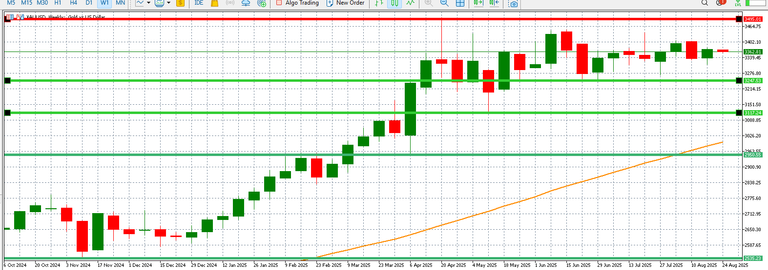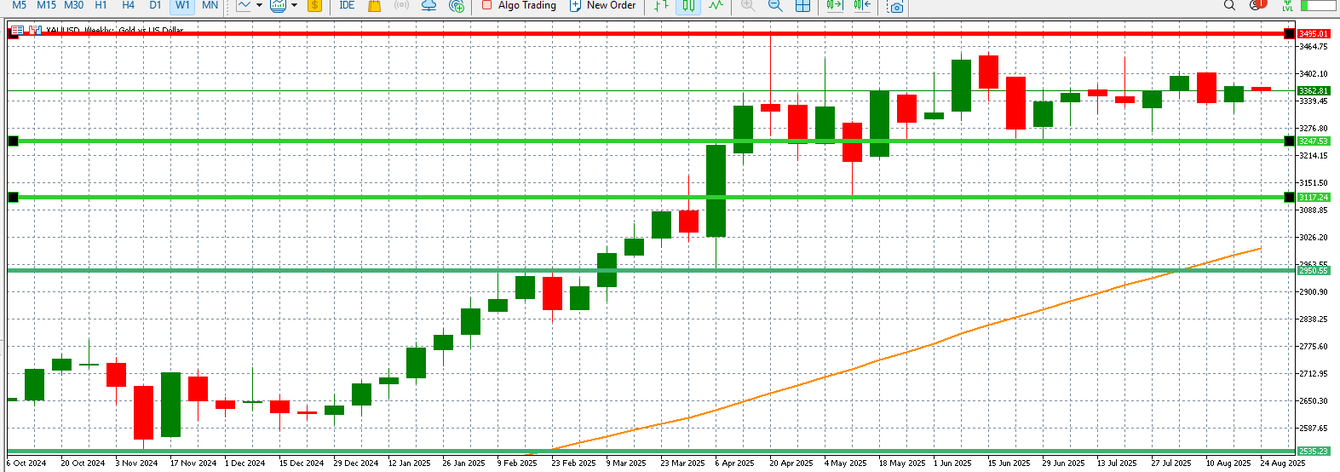Gold prices have begun the week under pressure, currently trading at $3,363. The early weakness is largely attributed to profit-taking following recent gains, coupled with a resurgence in the U.S. dollar index after two weeks of sustained sell-off. Investors have been adjusting positions, with some locking in profits from the recent rallies, while the stronger dollar has made gold slightly less attractive in dollar terms, creating headwinds for further immediate gains.
Gold Remains Stuck in a Tight Range
Looking at the broader price action over the past few weeks, gold remains firmly contained within a defined trading band. The highs formed at $3,451 in June and the lows at $3,255 have continued to act as strong resistance and support levels, respectively. Despite intermittent rallies and corrections, gold has struggled to decisively move outside this range, reflecting a market in consolidation.
Interestingly, this tight trading pattern persists even as equity markets have shown notable strength, particularly last week. Investor optimism was fueled by Federal Reserve Chairman’s remarks indicating readiness to cut interest rates. This spurred a risk-on environment, boosting equities and pushing investors away from safe-haven assets like gold. Currently, the market is pricing in more than a 75% probability of a 25 basis point Fed rate cut in September, signaling growing expectations for monetary easing.
Why Gold Isn’t Participating in the Rally
The primary reason gold has not benefitted from this backdrop is straightforward: gold typically struggles during risk-on rallies. When equities rise and investors’ appetite for risk increases, money flows away from non-yielding assets like gold and into higher-return instruments. Even with expectations of lower rates, the strong rally in stocks creates a counterweight that keeps gold contained within its current range. Traders are reluctant to add to gold positions while the equity markets offer momentum-driven opportunities.
Potential Catalysts for a Breakout
The question now is what could push gold out of its current zone. There are two clear scenarios that could trigger a breakout: a more aggressive Fed rate cut than currently priced in, or a sharp decline in broader markets.
If the Federal Reserve unexpectedly signals or enacts a more substantial rate cut than the 25 basis points currently expected, gold could respond sharply. Lower interest rates reduce the opportunity cost of holding non-yielding assets, making gold far more attractive. Additionally, a dovish Fed would likely reignite safe-haven demand and drive speculative positioning into precious metals.
The second scenario involves broader market declines. Should equity markets face a dramatic correction or sell-off, investors are likely to seek hedges, with gold serving as a natural beneficiary. In times of market turbulence, gold often attracts inflows as a store of value and a risk-off asset, pushing prices higher even if rate expectations remain largely unchanged.
Technical Levels to Watch
From a technical perspective, the current range provides a framework for traders. Support remains solid near $3,255, while resistance near $3,451 continues to cap the upside. Should either of the breakout scenarios occur — a dramatic rate cut or market sell-off — gold could quickly test these levels and potentially move beyond them. Traders will also be watching intraday price action around $3,363 to gauge short-term momentum and the balance between profit-taking and new buying interest.

Gold price chart: XTB
Conclusion
In summary, gold has started the week weaker, pressured by profit-taking and a rebounding dollar. The metal remains trapped in a range between $3,255 and $3,451 despite strong equities and expectations of an upcoming Fed rate cut. For a sustained breakout, the market needs either a more aggressive Fed policy move or a sharp decline in broader markets to drive safe-haven demand. Until one of these catalysts emerges, gold is likely to trade in a contained fashion, offering tactical opportunities for short-term traders but limited directional momentum for long-term investors.
Investors and traders should monitor Fed communications, market volatility, and equity trends closely this week. The combination of central bank policy and risk sentiment will determine whether gold remains range-bound or finally embarks on a decisive move.
